
Chapter 2 CMOS FABRICATION TECHNOLOGY AND DESIGN RULES
![[previous]](../left.gif)
![[Table of Contents]](../toc.gif)
![[next]](../right.gif)

![[previous]](../left.gif)
![[Table of Contents]](../toc.gif)
![[next]](../right.gif)
Notice: This chapter is a largely based on Chapter 2 (Fabrication of MOSFETs) of the book CMOS Digital Integrated Circuit Design - Analysis and Design by S.M. Kang and Y. Leblebici.
In this chapter, the fundamentals of MOS chip fabrication will be discussed and the major steps of the process flow will be examined. It is not the aim of this chapter to present a detailed discussion of silicon fabrication technology, which deserves separate treatment in a dedicated course. Rather, the emphasis will be on the general outline of the process flow and on the interaction of various processing steps, which ultimately determine the device and the circuit performance characteristics. The following chapters show that there are very strong links between the fabrication process, the circuit design process and the performance of the resulting chip. Hence, circuit designers must have a working knowledge of chip fabrication to create effective designs and in order to optimize the circuits with respect to various manufacturing parameters. Also, the circuit designer must have a clear understanding of the roles of various masks used in the fabrication process, and how the masks are used to define various features of the devices on-chip.
The following discussion will concentrate on the well-established CMOS fabrication technology, which requires that both n-channel (nMOS) and p-channel (pMOS) transistors be built on the same chip substrate. To accommodate both nMOS and pMOS devices, special regions must be created in which the semiconductor type is opposite to the substrate type. These regions are called wells or tubs. A p-well is created in an n-type substrate or, alternatively, an n- well is created in a p-type substrate. In the simple n-well CMOS fabrication technology presented, the nMOS transistor is created in the p-type substrate, and the pMOS transistor is created in the n-well, which is built-in into the p-type substrate. In the twin-tub CMOS technology, additional tubs of the same type as the substrate can also be created for device optimization.
The simplified process sequence for the fabrication of CMOS integrated circuits on a p- type silicon substrate is shown in Fig. 2.1. The process starts with the creation of the n-well regions for pMOS transistors, by impurity implantation into the substrate. Then, a thick oxide is grown in the regions surrounding the nMOS and pMOS active regions. The thin gate oxide is subsequently grown on the surface through thermal oxidation. These steps are followed by the creation of n+ and p+ regions (source, drain and channel-stop implants) and by final metallization (creation of metal interconnects).
![[Zoom]](../zoom.gif)
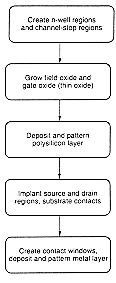
The process flow sequence pictured in Fig. 2.1 may at first seem to be too abstract, since detailed fabrication steps are not shown. To obtain a better understanding of the issues involved in the semiconductor fabrication process, we first have to consider some of the basic steps in more detail.
Note that each processing step requires that certain areas are defined on chip by appropriate masks. Consequently, the integrated circuit may be viewed as a set of patterned layers of doped silicon, polysilicon, metal and insulating silicon dioxide. In general, a layer must be patterned before the next layer of material is applied on chip. The process used to transfer a pattern to a layer on the chip is called lithography. Since each layer has its own distinct patterning requirements, the lithographic sequence must be repeated for every layer, using a different mask.
To illustrate the fabrication steps involved in patterning silicon dioxide through optical lithography, let us first examine the process flow shown in Fig. 2.2. The sequence starts with the thermal oxidation of the silicon surface, by which an oxide layer of about 1 micrometer thickness, for example, is created on the substrate (Fig. 2.2(b)). The entire oxide surface is then covered with a layer of photoresist, which is essentially a light-sensitive, acid-resistant organic polymer, initially insoluble in the developing solution (Fig. 2.2(c)). If the photoresist material is exposed to ultraviolet (UV) light, the exposed areas become soluble so that the they are no longer resistant to etching solvents. To selectively expose the photoresist, we have to cover some of the areas on the surface with a mask during exposure. Thus, when the structure with the mask on top is exposed to UV light, areas which are covered by the opaque features on the mask are shielded. In the areas where the UV light can pass through, on the other hand, the photoresist is exposed and becomes soluble (Fig. 2.2(d)).
![[Zoom]](../zoom.gif)
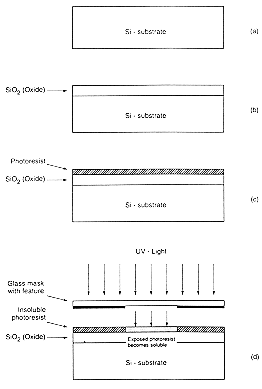
![[Zoom]](../zoom.gif)

The type of photoresist which is initially insoluble and becomes soluble after exposure to UV light is called positive photoresist. The process sequence shown in Fig. 2.2 uses positive photoresist. There is another type of photoresist which is initially soluble and becomes insoluble (hardened) after exposure to UV light, called negative photoresist. If negative photoresist is used in the photolithography process, the areas which are not shielded from the UV light by the opaque mask features become insoluble, whereas the shielded areas can subsequently be etched away by a developing solution. Negative photoresists are more sensitive to light, but their photolithographic resolution is not as high as that of the positive photoresists. Therefore, negative photoresists are used less commonly in the manufacturing of high-density integrated circuits.
Following the UV exposure step, the unexposed portions of the photoresist can be removed by a solvent. Now, the silicon dioxide regions which are not covered by hardened photoresist can be etched away either by using a chemical solvent (HF acid) or by using a dry etch (plasma etch) process (Fig. 2.2(e)). Note that at the end of this step, we obtain an oxide window that reaches down to the silicon surface (Fig. 2.2(f)). The remaining photoresist can now be stripped from the silicon dioxide surface by using another solvent, leaving the patterned silicon dioxide feature on the surface as shown in Fig. 2.2(g).
The sequence of process steps illustrated in detail in Fig. 2.2 actually accomplishes a single pattern transfer onto the silicon dioxide surface, as shown in Fig. 2.3. The fabrication of semiconductor devices requires several such pattern transfers to be performed on silicon dioxide, polysilicon, and metal. The basic patterning process used in all fabrication steps, however, is quite similar to the one shown in Fig. 2.2. Also note that for accurate generation of high-density patterns required in sub-micron devices, electron beam (E-beam) lithography is used instead of optical lithography. In the following, the main processing steps involved in the fabrication of an n-channel MOS transistor on p-type silicon substrate will be examined.
![[Zoom]](../zoom.gif)
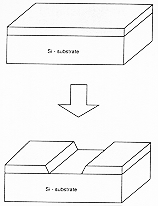
The process starts with the oxidation of the silicon substrate (Fig. 2.4(a)), in which a relatively thick silicon dioxide layer, also called field oxide, is created on the surface (Fig. 2.4(b)). Then, the field oxide is selectively etched to expose the silicon surface on which the MOS transistor will be created (Fig. 2.4(c)). Following this step, the surface is covered with a thin, high-quality oxide layer, which will eventually form the gate oxide of the MOS transistor (Fig. 2.4(d)). On top of the thin oxide, a layer of polysilicon (polycrystalline silicon) is deposited (Fig. 2.4(e)). Polysilicon is used both as gate electrode material for MOS transistors and also as an interconnect medium in silicon integrated circuits. Undoped polysilicon has relatively high resistivity. The resistivity of polysilicon can be reduced, however, by doping it with impurity atoms.
After deposition, the polysilicon layer is patterned and etched to form the interconnects and the MOS transistor gates (Fig. 2.4(f)). The thin gate oxide not covered by polysilicon is also etched away, which exposes the bare silicon surface on which the source and drain junctions are to be formed (Fig. 2.4(g)). The entire silicon surface is then doped with a high concentration of impurities, either through diffusion or ion implantation (in this case with donor atoms to produce n-type doping). Figure 2.4(h) shows that the doping penetrates the exposed areas on the silicon surface, ultimately creating two n-type regions (source and drain junctions) in the p-type substrate. The impurity doping also penetrates the polysilicon on the surface, reducing its resistivity. Note that the polysilicon gate, which is patterned before doping actually defines the precise location of the channel region and, hence, the location of the source and the drain regions. Since this procedure allows very precise positioning of the two regions relative to the gate, it is also called the self-aligned process.
![[Zoom]](../zoom.gif)
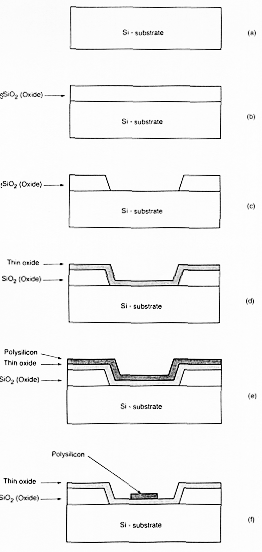
![[Zoom]](../zoom.gif)

![[Zoom]](../zoom.gif)
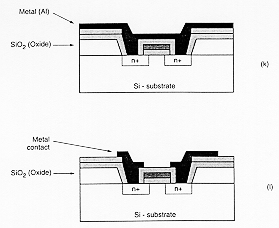
Once the source and drain regions are completed, the entire surface is again covered with an insulating layer of silicon dioxide (Fig. 2.4(i)). The insulating oxide layer is then patterned in order to provide contact windows for the drain and source junctions (Fig. 2.4(j)). The surface is covered with evaporated aluminum which will form the interconnects (Fig. 2.4(k)). Finally, the metal layer is patterned and etched, completing the interconnection of the MOS transistors on the surface (Fig. 2.4(l)). Usually, a second (and third) layer of metallic interconnect can also be added on top of this structure by creating another insulating oxide layer, cutting contact (via) holes, depositing, and patterning the metal.
Having examined the basic process steps for pattern transfer through lithography, and having gone through the fabrication procedure of a single n-type MOS transistor, we can now return to the generalized fabrication sequence of n-well CMOS integrated circuits, as shown in Fig. 2.1. In the following figures, some of the important process steps involved in the fabrication of a CMOS inverter will be shown by a top view of the lithographic masks and a cross-sectional view of the relevant areas.
The n-well CMOS process starts with a moderately doped (with impurity concentration typically less than 1015 cm-3) p-type silicon substrate. Then, an initial oxide layer is grown on the entire surface. The first lithographic mask defines the n-well region. Donor atoms, usually phosphorus, are implanted through this window in the oxide. Once the n-well is created, the active areas of the nMOS and pMOS transistors can be defined. Figures 2.5 through 2.10 illustrate the significant milestones that occur during the fabrication process of a CMOS inverter.
![[Zoom]](../zoom.gif)
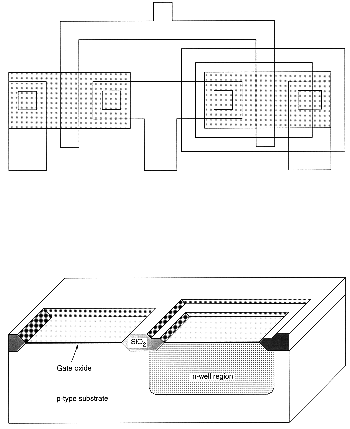
![[Zoom]](../zoom.gif)
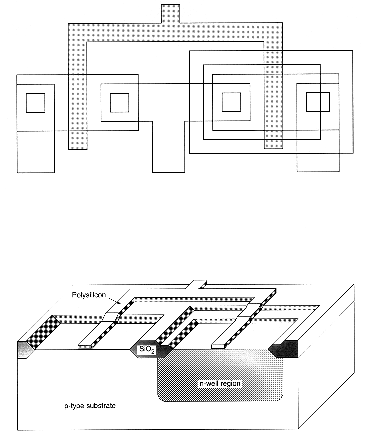
![[Zoom]](../zoom.gif)
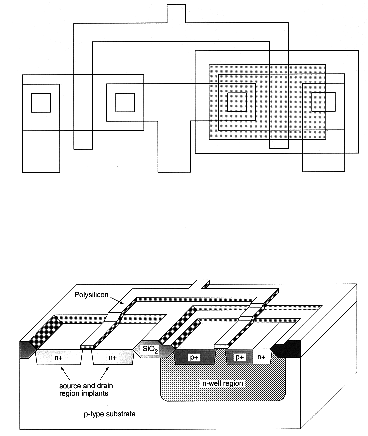
![[Zoom]](../zoom.gif)
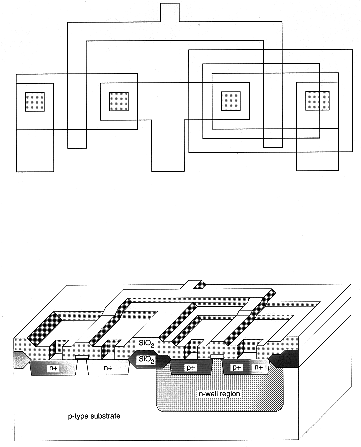
![[Zoom]](../zoom.gif)
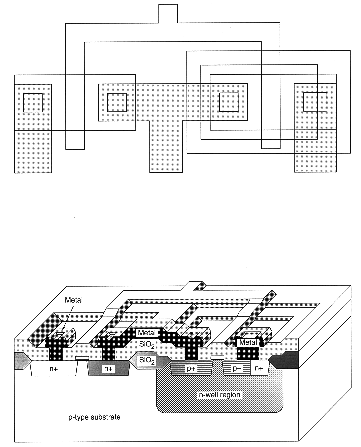
![[Zoom]](../zoom.gif)
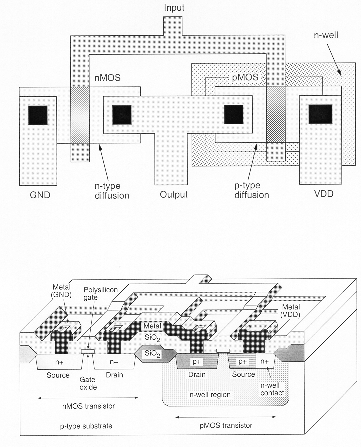
The patterning process by the use of a succession of masks and process steps is conceptually summarized in Fig. 2.11. It is seen that a series of masking steps must be sequentially performed for the desired patterns to be created on the wafer surface. An example of the end result of this sequence is shown as a cross-section on the right.
![[Zoom]](../zoom.gif)
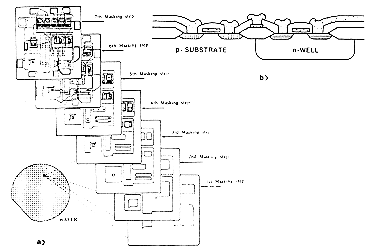
In this section, two examples will be given for advanced CMOS processes which offer additional benefits in terms of device performance and integration density. These processes, namely, the twin-tub CMOS process and the silicon-on-insulator (SOI) process, are becoming especially more popular for sub-micron geometries where device performance and density must be pushed beyond the limits of the conventional n-well CMOS process.
Twin-Tub (Twin-Well) CMOS Process
This technology provides the basis for separate optimization of the nMOS and pMOS transistors, thus making it possible for threshold voltage, body effect and the channel transconductance of both types of transistors to be tuned independently. Generally, the starting material is a n+ or p+ substrate, with a lightly doped epitaxial layer on top. This epitaxial layer provides the actual substrate on which the n-well and the p-well are formed. Since two independent doping steps are performed for the creation of the well regions, the dopant concentrations can be carefully optimized to produce the desired device characteristics.
In the conventional n-well CMOS process, the doping density of the well region is typically about one order of magnitude higher than the substrate, which, among other effects, results in unbalanced drain parasitics. The twin-tub process (Fig. 2.12) also avoids this problem.
![[Zoom]](../zoom.gif)
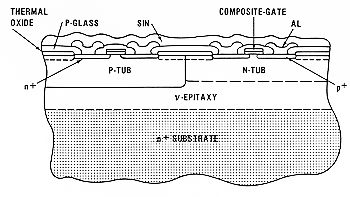
Silicon-on-Insulator (SOI) CMOS Process
Rather than using silicon as the substrate material, technologists have sought to use an insulating substrate to improve process characteristics such as speed and latch-up susceptibility. The SOI CMOS technology allows the creation of independent, completely isolated nMOS and pMOS transistors virtually side-by-side on an insulating substrate (for example: sapphire). The main advantages of this technology are the higher integration density (because of the absence of well regions), complete avoidance of the latch-up problem, and lower parasitic capacitances compared to the conventional n-well or twin-tub CMOS processes. A cross-section of nMOS and pMOS devices in created using SOI process is shown in Fig. 2.13.
The SOI CMOS process is considerably more costly than the standard n-well CMOS process. Yet the improvements of device performance and the absence of latch-up problems can justify its use, especially for deep-sub-micron devices.
![[Zoom]](../zoom.gif)

The physical mask layout of any circuit to be manufactured using a particular process must conform to a set of geometric constraints or rules, which are generally called layout design rules. These rules usually specify the minimum allowable line widths for physical objects on-chip such as metal and polysilicon interconnects or diffusion areas, minimum feature dimensions, and minimum allowable separations between two such features. If a metal line width is made too small, for example, it is possible for the line to break during the fabrication process or afterwards, resulting in an open circuit. If two lines are placed too close to each other in the layout, they may form an unwanted short circuit by merging during or after the fabrication process. The main objective of design rules is to achieve a high overall yield and reliability while using the smallest possible silicon area, for any circuit to be manufactured with a particular process.
Note that there is usually a trade-off between higher yield which is obtained through conservative geometries, and better area efficiency, which is obtained through aggressive, high- density placement of various features on the chip. The layout design rules which are specified for a particular fabrication process normally represent a reasonable optimum point in terms of yield and density. It must be emphasized, however, that the design rules do not represent strict boundaries which separate "correct" designs from "incorrect" ones. A layout which violates some of the specified design rules may still result in an operational circuit with reasonable yield, whereas another layout observing all specified design rules may result in a circuit which is not functional and/or has very low yield. To summarize, we can say, in general, that observing the layout design rules significantly increases the probability of fabricating a successful product with high yield.
The design rules are usually described in two ways :
Micron rules, in which the layout constraints such as minimum feature sizes and minimum allowable feature separations, are stated in terms of absolute dimensions in micrometers, or,
Lambda rules, which specify the layout constraints in terms of a single parameter (?) and, thus, allow linear, proportional scaling of all geometrical constraints.
Lambda-based layout design rules were originally devised to simplify the industry- standard micron-based design rules and to allow scaling capability for various processes. It must be emphasized, however, that most of the submicron CMOS process design rules do not lend themselves to straightforward linear scaling. The use of lambda-based design rules must therefore be handled with caution in sub-micron geometries. In the following, we present a sample set of the lambda-based layout design rules devised for the MOSIS CMOS process and illustrate the implications of these rules on a section a simple layout which includes two transistors (Fig. 2.14).
MOSIS Layout Design Rules (sample set) Rule number Description L-Rule R1 Minimum active area width 3 L R2 Minimum active area spacing 3 L R3 Minimum poly width 2 L R4 Minimum poly spacing 2 L R5 Minimum gate extension of poly over active 2 L R6 Minimum poly-active edge spacing 1 L (poly outside active area) R7 Minimum poly-active edge spacing 3 L (poly inside active area) R8 Minimum metal width 3 L R9 Minimum metal spacing 3 L R10 Poly contact size 2 L R11 Minimum poly contact spacing 2 L R12 Minimum poly contact to poly edge spacing 1 L R13 Minimum poly contact to metal edge spacing 1 L R14 Minimum poly contact to active edge spacing 3 L R15 Active contact size 2 L R16 Minimum active contact spacing 2 L (on the same active region) R17 Minimum active contact to active edge spacing 1 L R18 Minimum active contact to metal edge spacing 1 L R19 Minimum active contact to poly edge spacing 3 L R20 Minimum active contact spacing 6 L (on different active regions)
![[Zoom]](../zoom.gif)
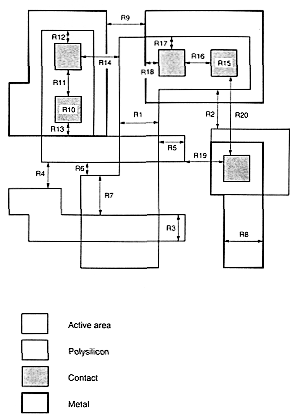
This chapter edited by Y. Leblebici